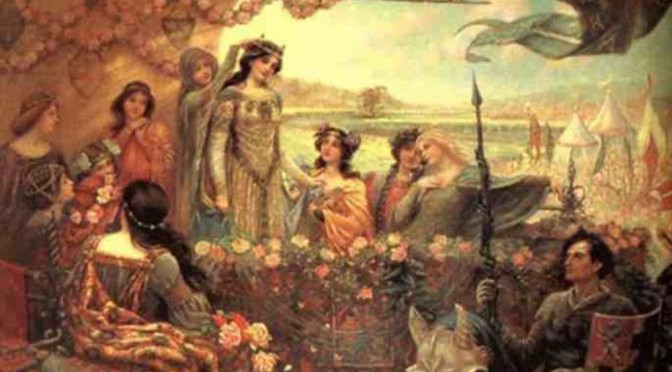There is little doubt that Occitan has the right to be considered a Nation.
“What makes a Nation? Speaking the same language; having the same culture, worshipping the same god, living in an area clearly delineated by natural features, being prepared to group together for mutual defense? By all these criteria there is a state of Occitan.”
Occitan was admired by some but attacked by the Church of Rome not just because of its adherance to the Cathar faith but also because of its unique culture. The two; Culture and Religion were strongly linked.
Cohesion.
As a gesture of humility, all Cathars were required, regardless of their position in society. to spend time performing physical work.
Many chose weaving or tailoring. Some chose farm work. If the immediate locallity supported a specific industry, it was considered a good choice to work in that industry. It made everyone aware of the working conditions in that industry.
The feudal system was quite different. It was not predominently about services and reciprocal protection . It was about working together for thr benefit of the community. The community organised it self to provide a high standard of community housing, community meeting houses and community schooling.
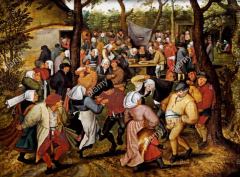 Successful industies were launched. The Albi-Toulouse-Carcassonne triangle became known as the ‘Pays de Cocagne’ (Land of Plenty), a word that derives from the balls of paste (Occitan coucagno) formed during the manufacturing process for blue dye made from the pastel plan. The nickname became synonymous with wealth and abundance.A mythical land of extreme luxury and ease where physical comforts and pleasures are always immediately at hand and where the harshness of medieval peasant life does not exist.
Successful industies were launched. The Albi-Toulouse-Carcassonne triangle became known as the ‘Pays de Cocagne’ (Land of Plenty), a word that derives from the balls of paste (Occitan coucagno) formed during the manufacturing process for blue dye made from the pastel plan. The nickname became synonymous with wealth and abundance.A mythical land of extreme luxury and ease where physical comforts and pleasures are always immediately at hand and where the harshness of medieval peasant life does not exist.
Trade routes were established to the major Atlantic ports, up to Lyon and the Low Countries and down into Spain. Apparently, on the 8th November 1404, 13 ships from Bayonne and four from Bordeaux landed 127 cubic metres of pastel at Bristol. This gives some idea of the extent of the trade by that date.
Those with talents were provided with opportunitis to develop those talents. It was a model for the later trade guilds and trade apprenticships. Barriers between various levels of society were reduced and a cohesive spirit engendered.
What the inhabitants of Occitan did not fulfil was the Church of Rome’s requirement to give one tenth of all their income in tithes. The Church hated them for this and found that excommunication was useless as a means of imposing disipline.
Faith And Love
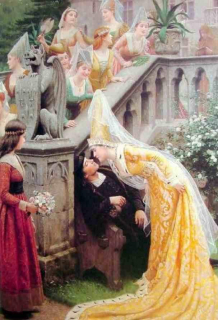 Both formally and informally, Occtan was a world controlled by the rules of the Courts of Love, not the church of Rome.
Both formally and informally, Occtan was a world controlled by the rules of the Courts of Love, not the church of Rome.
The jongleurs, the troubadors, and devotion to a state of sexual exitement were the recognisable hallmark of Occitan society
These courts are a woman’s world, into which a man may enter, but only if he accepts the rules. The Courts of Love were the physical means devised to comply with important tenents of the Cathar faith ; women should have complete control of every sexual encounter,
The object was to ensure that the conception of children should be limited which in turn hence women are totally control of all sexual activity.
If a man wished to pay court to woman, then he must visit her and in front of friends and family make his suit publicly. Even if the woman accepts the suit it will only be allowed to progress at a place and time of her choosing.
This situation is not abhorrent to Cathar men. They know the rules and that even after marriage, it is socially acceptable to seek relationships with other women. The big difference between Cathar and Roman worlds is of course, that even after marriage it is socially acceptable for women to encourage male admirers.
De Amore
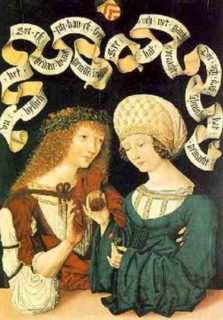
Extracts from De Amore by Andreas Capellanus 1186
The website “medieval spell” summarises the writing of Capellanus.
-
“Courtly love is sensual.”
Andreas Capellanus defines love as a passion arising from the contemplation of beauty in the opposite sex, and it is on this definition that the whole system rests. The sensual element contrasts with the high ideals of conduct and character presented in parallel throughout the book, but this discrepancy is according to the love as it was practised by the courtly society. Though essentially impure, it was yet exalted as ennobling of every virtue.
2. “Courtly love is illicit and, for the most part, adulterous.”
In the courtly love system marriage has no place. It is the first law of the longer code, which frankly states that a woman cannot plead marriage as a sufficient excuse for denying a lover’s petition.
3. “A love, sensual and illicit, must be secret and furtive.”
The shorter code lays this down as a law. The longer version adds, as the reason, that a love which is divulged rarely lasts. Despite the moral laxness of the society out of which the courtly love grew, there were many to whom these ideas were morally repugnant.
4. “Love must not be too easily obtained.”
This principle is seen at work when the capriciousness of the lady is causing all the lover’s woes as they are described in the poems of the troubadours.
According to Capellanus, love should always be associated with courtesy and largess, being always banished from the domicile of avarice.
He believes that love makes the rude excel in grace, and those of low birth show a noble character.
No breach of the rules could be more serious than for a lover, woman or man, to be unfaithful. This idea also appears in other erotic literature of the period, as well as in the following centuries.
Sensualism aside, the high position held by woman in the society of the time, and the reverence with which she was regarded caused the high ideals of the courtly system.
This stands, not only in matters of etiquette, but of honor as well. Though sensual love underlay the system, voluptuousness was regarded as killing the real love, and the lover was required to show nobility of character and moderation in all his conduct.
The nature of love
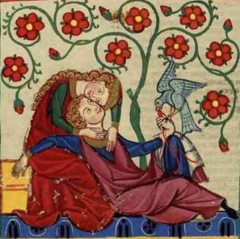 The writings of CapellanusThe writings include general observations on the nature of love:-
The writings of CapellanusThe writings include general observations on the nature of love:-
No one should be deprived of love without the very best of reasons.
No one can love unless they are propelled by the persuasion of love.
Marriage is no real excuse for not loving.
Nothing forbids one woman being loved by two men or one man by two women.
The easy attainment of love makes it of little value: difficulty of attainment makes it prized.
When made public love rarely endures.
That which a lover takes against the will of his beloved has no relish.
It is not proper to love anyone whom one would be ashamed to seek to marry.
It is well known that love is always increasing or decreasing.
A new love puts an old one to flight.
Every act of a lover ends in the thought of his beloved.
A true lover considers nothing good except what he thinks will please his beloved.
Love can deny nothing to love.
A true lover is constantly and without intermission possessed by the thought of his beloved.
A true lover does not desire to embrace in love anyone except his beloved.
Good character alone makes any man worthy of love.
If love diminishes, it quickly fails and rarely revives.
Every lover regularly turns pale in the presence of his beloved.
When a lover suddenly catches sight of his beloved his heart palpitates.
A lover can never have enough of the solaces of his beloved.
The meaning of Marriage
Marriage here means the Cathar contract of marriage, not the Roman Church’s Sacrament Of Marriage, which is totally different and to Cathars very threatening.
By 1350 however most Cathars submitted to a Roman Marriage to avoid attracting the attention of the Inquisition. For them however the Roman marriage has little or no significance other than giving them protection
Eleanor’s influence
 Attendance at court was central to social life.A distinction must also be made between the sovereign courts of kings and counts and the courts of love. The sovereign courts attracted people of rank, intellect and sophisticated tastes, and was a centre of learning and culture. Its members were wealthy, privileged and overwhelmingly preoccupied with the securing of patronage and the accumulation of material luxuries.
Attendance at court was central to social life.A distinction must also be made between the sovereign courts of kings and counts and the courts of love. The sovereign courts attracted people of rank, intellect and sophisticated tastes, and was a centre of learning and culture. Its members were wealthy, privileged and overwhelmingly preoccupied with the securing of patronage and the accumulation of material luxuries.
It must be realised that the Norman Rulers of England were by descent from Eleanor of Auitaine very much influenced by Cathar culture.
Alison Wier in her book, “Katherine Swynford” discusses the court of Edward III:-
“Display was what mattered, they dined in style on rich and novel cuisine, drank to excess, and dressed in extravagantly fashionable and colourful clothes, women’s necklines were very low and often left their breasts half bared, while young men wore such clinging hose beneath their short jackets (paltrocks) that little was left to the imagination.Elaborate headgear, shoes with long pointed toes, trailing sleves and belts slung seductively low on the hips completed these ensembles for both sexes and a profusion of jewellery was de rigueur. Not surprisingly these pampered gaudily attired courtiers shocked the King’s more sober subjects not only by their revealing dress but also by their licentious conduct.”
However the courts of love were frequently totally separate from regal courts, in the homes of people at all levels in society or in the meeting houses.
The Progression
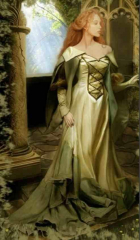 Young Cathar people were elevated to the status of “Credentes” in their sixteenth year in ceremony known as “The Progression”.
Young Cathar people were elevated to the status of “Credentes” in their sixteenth year in ceremony known as “The Progression”.
The ceremony is in a format, which symbolizes a court of love. Girls and boys demonstrate that they have learned the necessary etiquette and therefore are ready to move on to “The Transition”.
 Practical experience in how to give and receive pleasure.There is no sin in sexual activity and sexual pleasure however it is gained. Sexual Pleasure is the good god’s way of giving us a small sample of what ultimate union with him will be like.
Practical experience in how to give and receive pleasure.There is no sin in sexual activity and sexual pleasure however it is gained. Sexual Pleasure is the good god’s way of giving us a small sample of what ultimate union with him will be like.
This was a key point of difference between Cathars and the Roman Church. Because it is such a vital aspect of the religion, all young Credentes are given instruction in how to give and receive pleasure. This includes practical experience, under tuition. Generally this is with someone of his or her own age, and of his or her own choice. It is intended to be a fulfilling and liberating experience and usually it is. For a minority the almost clinical nature of the instruction separates sexual pleasure from love and affection. When this does happen the damage caused is difficult to repair.
The laws of inheritance were also quite different. There was no distinction between male and female , no distinction between eldest and youngest, no distinction between legitimate and illegitimate. All that was need was for a man to acknowledge a child as his own and that child would inherit in equal propotions to legitimate sibling.
In consequence territorial rights were subdivided and then rejoined by marriage, but in ever shifting combinations. In the face of concerted external pressure this lead to dynastic and territorial instability.
Despite the acceptance of sexual relationships outside of marriage. the thoughtless conception of children was considered to be sinful,
The net result was that Cathars had relatively few children and the children they did concieve were considered to be “the good god’s heroes”; the minimum required to carry the Cathar faith into the next generation. This meant however, that there were few big families from which military forces could be drawn. This was in direct contrast with nations who followed the Roman faith where the law of primagenture meant that there were many children without inheritance prepared to seek their fortune in military action.
